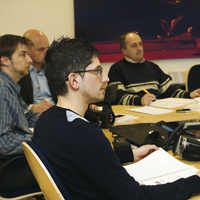 BINDT Accreditation For Flir Infrared Training
BINDT Accreditation For Flir Infrared Training
Thermal imaging is now an industry standard method for condition monitoring and preventive maintenance. Its efficiency and application flexibility has driven its take-up across all industrial sectors and as a result camera costs have fallen thanks to manufacturing economies. (Read More)
The technology is now eminently affordable and accessible to an increasingly wider engineering community and the need for dedicated training has become an increasingly important and natural by-product.
Advertisement - Hover to see more
Advertisement - Hover to see more
Technology leader, FLIR Systems, has always been a staunch proponent of expert training. It not only ensures that the user gets the best return on the camera investment but also that application standards are upheld. For this purpose, the company created its Infrared Training Centre (ITC), an independent organisation that provides courses that range from foundation through to professional level.
These courses have been continuously developed over time by ITC experts. They are based on the collective experience of ITC worldwide to determine what thermographers need to know. And these learning objectives are part of the ISO compliant quality control system of FLIR Systems in both Sweden and the United States.
All students who complete a Level I, Level II or Level III training course are eligible for ITC certification which is valid for five years. To be re-certified for an additional five years, the student must demonstrate continuing education in, or professional contribution to, the field of thermography.
Level I to III qualification
So what do these various qualifications mean? A Level I thermographer is certified to perform industrial thermographic measurements and fundamental infrared thermography, including basic image post-processing according to established and recognized procedures. This includes the use of measurement tools, emissivity adjustments and span & scale adjustments.
Put simply, a Level I thermographer can use the equipment without knowing too much about its inner workings and perform uncomplicated measurements following existing routines. He or she will be able to detect obvious faults, recognize possible errors in measurement and carry out post processing and data collection.
In the Level I training course, the emphasis is very much on hands-on training. Theory is kept as simple as possible and use of formulas, minimised. Whilst the student will leave the course as a competent user of an infrared camera they would need to defer to a higher-qualified person to define inspection routines and guidelines.
Greater depth
In the Level II course, this knowledge base is expanded. The training course includes more theory and goes deeper into the physical laws that the infrared camera uses to generate an image and measure temperature. It also explores the causes, anomalies and patterns that are commonly encountered in thermal imaging.
The student uses more formulas and is expected to be able to perform simple calculations. Steady state and transient mechanisms are examined in more detail and the course work involves more laboratory experiments. As a result the certified Level II thermographer is qualified to perform and direct infrared thermography according to established and recognised procedures.
For any professional thermographer, Level III certification is the gold standard. It signifies wide experience and a standard of knowledge that meets internationally recognised criteria.
The goal of this course is to enable pre-qualified Level II thermographers to set up and run a successful condition monitoring programme. And as such, the instruction includes guidance on acquiring and developing the necessary personnel, resources and technologies.
BINDT Accreditation
All FLIR certification courses are already highly regarded for their quality and depth but now this has been independently verified. FLIR Level I and Level II thermography courses have been validated by the British Institute of Non-Destructive Testing (BINDT) against its minimum requirements for structured training of condition monitoring practitioners.
BINDT is world renowned. Its aim is to promote and advance the science and practice of non-destructive testing, condition monitoring, diagnostic engineering and all other materials and quality testing disciplines. FLIR has worked closely with this organisation for many years with the aim of creating a quality standard in infrared training.
“We are delighted that our courses have been ratified by such an important industry body,” concluded Jon Willis FLIR Systems’ ITC Manager. “This achievement also gives industry the assurance that the training we provide is in compliance with ISO18436 requirements for the training and qualification of personnel.”
Contact details:
FLIR Systems, 2 Kings Hill Avenue, Kings Hill, West Malling, Kent. ME19 4AQ
Tel: +44(0)1732 220011
ITC email contacts:
This email address is being protected from spambots. You need JavaScript enabled to view it. | This email address is being protected from spambots. You need JavaScript enabled to view it.
Websites: www.flir.com | www.irtraining.eu



